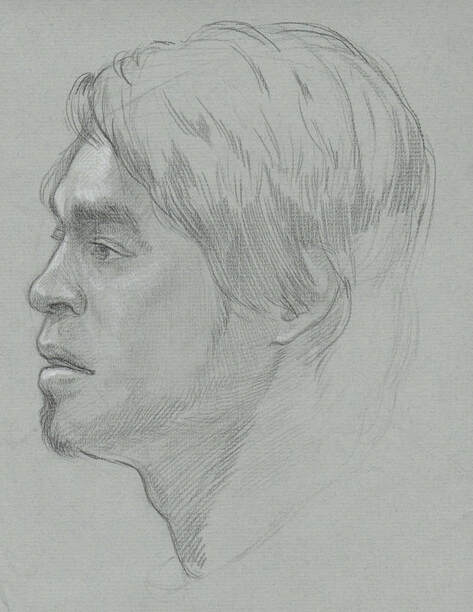The Creative Conventions of Portraiture
Have you ever wanted to draw someone’s portrait? This introduction to the art of portraiture aims to expand your understanding of the portrait beyond that of a well observed and static reproduction of the human head, by conceiving of the human head within the context of portraiture conventions, as an integrated part of the human body and as a vehicle for emotional expression. This course is suitable for both beginners and those with some drawing experience. Cost of life model included in fee.
COURSE OUTLINE
- The Structure of the Human Head: Discuss the proportions of the human head and the anatomy of the skull, including the relationship of the head to the neck and upper torso. We will note the importance of initially demarcating the position of the ear (or the external acoustic metus of the skull) when the head is drawn in profile. The features of the face will be seen within the context of conceptualising the head in terms of a simplified overarching egg shape.
- Portraiture and the convention of the open mouth: The model will be asked to breathe through their mouth while posing, allowing the student to convey a sense of the living sitter breathing or about to speak.
- Foreshortening and the human head: The model will be asked to stand and the student will draw the head as seen from below. The importance of the under planes of the head will be addressed.
- The body in portraiture: This class will begin to integrate the process of perceiving the head as integral to the figure as a whole, both in terms of bodily action and emotional expression within portraiture. We will look at the convention of the waist-high portrait as seen in the works of Leonardo da Vinci and the Venetian painter Titian. The use of geometric shapes to frame the pose, such as the triangle, will be examined.
- Drawing the passions: We will look at the French painter, Charles le Brun’s understanding of facial expressions and how bodily actions are used to convey emotion. A model with a background in performance will seek to embody a range of emotional states through their facial expressions and bodily actions. The muscular anatomy of the human head as it relates to expression will also be addressed.
- The full figure portrait: Looking at portraiture conventions that relate to the figure as a whole, we will consider how the gesture of the whole body is employed to convey the character of the sitter.
PLANNED LEARNING OUTCOMES
By the end of this course, students should be able to:
- Conceive of the head and the features of the face in terms of basic overarching geometric masses.
- Gain a basic knowledge of the anatomy of the skull and the muscles of the head, neck and parts of the upper torso.
- Observe and conceptualise the relationship between facial physiognomy and conveying human emotion within a portrait.
- Gaining practical and applicable knowledge of art historical conventions for portraiture.
- Understand the interrelationship of the body to the head in portraiture.
MATERIALS LIST
- A range of pencils (Note: hard pencils either H or 2H are recommended for beginners)
- Oil based red sanguine, black and white chalk pencils. (Faber Castel or alternative brand)
- Kneadable eraser
- Stanley knife for sharpening pencils
- Two metal paper clips
- Medium sized sketch book
When:
Monday 14 October - 2 December 2019
6.00 PM - 8.30 PM
Where:
WEA Sydney
72 Bathurst Street
Previous course feedback:
'I still consider Dominique Millar, the best tutor ever, to be an absolute mine of information and inspiration and I am very grateful to him for everything I am learning in his classes. I always look forward not only to the next term but also to the next lesson, knowing that I will learn something new, something interesting, something useful and wonderful. I also know that my classmates are of the same opinion.'
'Loved the course, Dominique was excellent - structured class and so informative. For me, it was also a history lesson on some of the famous artists!'
"Dominique was so friendly and easy to understand. I was instantly relaxed, though I had been a little anxious that I would be slow to understand
him as I am 83 and have never learnt to draw. But I loved every minute. The classes pushed my concentration to the limit, yet I came away feeling
I must learn more! Thank you Dominique."
Jennifer
